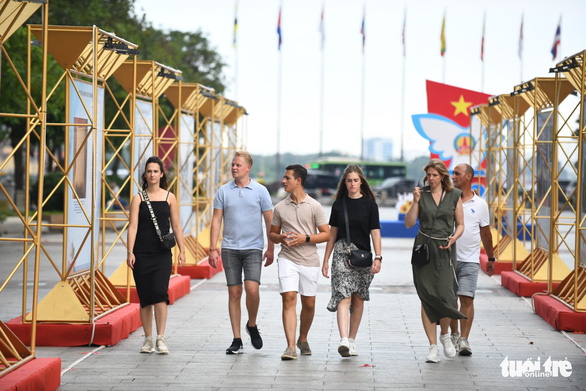With the peak summer travel season drawing to a close, Vietnam’s international tourism segment still faces bottlenecks on its route to full recovery.
Within the framework of a program early this week to discuss the current state of the Vietnamese tourism sector, representatives from businesses and organizations across the country voiced doubts that Vietnam will meet its goal of welcoming five million foreign tourists by the end of the year if regulations governing visa policies, infrastructure, and personnel are not relaxed.
Incomplete recovery
According to Cao Thi Tuyet Lan, sales manager at Viettours Incentives & Events Co. Ltd., foreign tourists still find it difficult to enter the country despite Vietnam having fully reopened its borders.
“What's more, it is hard to apply for visas for business travelers who work with domestic enterprises," Lan said.
“[The domestic partner] first has to register [the foreign partner] with the Immigration Department, then wait for a week to submit a visa application.
“If these bottlenecks are not removed quickly, the number of foreign tourists [Vietnam welcomes this year] will not be high."
Echoing Lan’s sentiment, Phung Quang Thang, director of Hanoitourist, noted that Vietnam should prioritize international tourism given that the revenue from the 18 million foreign visitors it welcomed in 2019 was significantly higher than that from the 85 million domestic tourists who took holidays that same year.
Revamping tourism promotion
In addition to welcoming an extremely modest number of international visitors, tourism infrastructure in hotspots across the country have yet to be restored after nearly two years of minimal use, and tourism promotional activities remain sluggish.
Vo Anh Tai, deputy general director of Saigontourist Group, suggested that municipal and provincial authorities develop products, programs, conferences, and seminars on tourism, as well as host diplomatic, cultural, and sporting events to welcome foreign delegations from key markets.
Cao Tri Dung, chairman of the Da Nang Tourism Association, recommended that Vietnam build a big data platform that will allow tourism organizations to directly access customer information in order to improve promotional activities.
“Besides traditional promotion activities, such as organizing roadshows and participating in international fairs, local tourism should be promoted through digital channels," Dung said.
“Foreign tourists say Bali is not attractive anymore, but they aren’t sure of an alternative.
"Vietnam has great tourism products, but isn’t great at promoting them.”
Easing the visa process
Nguyen Trung Khanh, chairman of the Vietnam National Administration of Tourism, used the event to share that the Southeast Asian country welcomed 733,400 foreign tourists between January and July, approximately 15 percent of its five-million-foreign-tourist target.
In addition to the facts that Vietnam’s peak tourism season usually hits during the second half of the year and COVID-19 prevention policies are enforced by different countries, Khanh attributed the international tourism sector’s slow recovery to shortcomings in renewing commercial tourism products and a lack of personnel.
Vu The Binh, chairman of the Vietnam Tourism Association, countered Khanh’s argument by citing obstacles in the visa process as the primary reason foreign tourists are not visiting Vietnam, going as far as suggesting that the country extend the visa waiver period it currently has in place for certain countries to 30 or 60 days from 15 days.
“The recovery and development of Vietnam’s international tourism sector are urgent for more than 40,000 enterprises and two million workers in the industry, as well as millions of people who indirectly benefit from tourism,” Binh affirmed.
At a recent meeting with tourism-related enterprises, Minister of Culture, Sports, and Tourism Nguyen Van Hung said that the number of foreign tourists was smaller than expected but he highlighted that the sector is not all doom and gloom.
Hung cited the number of foreign arrivals this year as 950,000, a 10-fold increase over 2021, crediting it to the General Statistics Office.
Despite its desire to fully recover, Vietnamese tourism is dependent on other countries’ reopening policies.
The Russia-Ukraine military conflict has also affected one of Vietnam’s largest source markets – the Russian Federation.
Meanwhile, Japan and South Korea are still heavily focused on fighting the COVID-19 pandemic.
“We are striving to attract tourists. We will review visa policies and create favorable conditions for reopening,” the minister said.
Regarding proposals on easing visa policies, Minister Hung said the prime minister had recently held a meeting with the relevant ministries, including the Ministry of Public Security and the Ministry of Foreign Affairs, to clear obstacles facing international tourists.
In the coming periods, immigration policies will be surely relaxed, Hung assured, adding that enterprises should, in the meantime, prepare resources to improve their services.
Modest number of foreign visitors to Ho Chi Minh City
According to Phan Thi Thang, deputy chairwoman of the Ho Chi Minh City People’s Committee, the city served around 13.3 million domestic travelers and more than 765,000 foreign tourists from January through July, bringing in revenues of nearly VND60.4 trillion (US$2.6 billion), surging 57.82 percent year on year.
Nevertheless, the number of foreign guests was well below the figure recorded in the pre-pandemic period, Thang added.
Many other localities faced the same fate. Among the more than 1.45 million tourists who visited the central coastal province of Khanh Hoa during that seven-month period, over 1.38 million were local tourists and only 70,000 were foreigners.
The number of local visitors to the province was equal to 57 percent of that logged during the same period in 2019, while the ratio was only five percent for foreign tourists.
According to the General Statistics Office, Vietnam welcomed 954,600 international arrivals from January through July, skyrocketing 10 times over the same period last year but plunging 90.3 percent over the same period in 2019.
The country generated VND324.9 trillion ($14 billion) from lodging and catering services, and VND11.9 trillion ($511.2 million) from traveling services.
Like us on Facebook or follow us on Twitter to get the latest news about Vietnam!

















































